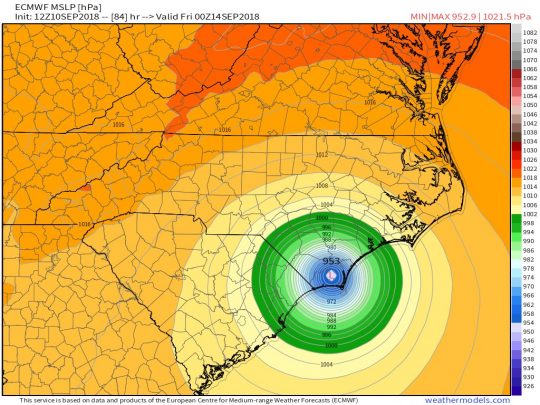Hurricane Florence To Intensify “To Near Category 5 Strength” And There Are 12 Nuclear Power Reactors In The Carolinas
 The latest forecast is projecting that Hurricane Florence will strengthen “to near category 5 strength” before it makes landfall in the Carolinas, and it is being called “a serious threat to lives and property”. It is extremely rare for a hurricane of this intensity to come this far north, and one expert is claiming that Florence “has the potential to be the most destructive hurricane we’ve had in modern history for this region.” At this time, the government is warning of “a life-threatening storm surge” of up to 20 feet or higher, “life-threatening freshwater flooding”, and “damaging hurricane-force winds”. But there is another factor that not a lot of people are talking about. There are 12 nuclear power reactors in the Carolinas, including two that are located right along the coast.
The latest forecast is projecting that Hurricane Florence will strengthen “to near category 5 strength” before it makes landfall in the Carolinas, and it is being called “a serious threat to lives and property”. It is extremely rare for a hurricane of this intensity to come this far north, and one expert is claiming that Florence “has the potential to be the most destructive hurricane we’ve had in modern history for this region.” At this time, the government is warning of “a life-threatening storm surge” of up to 20 feet or higher, “life-threatening freshwater flooding”, and “damaging hurricane-force winds”. But there is another factor that not a lot of people are talking about. There are 12 nuclear power reactors in the Carolinas, including two that are located right along the coast.
According to Google, there are 7 nuclear power reactors in South Carolina…
South Carolina hosts seven operating nuclear power reactors: Catawba Units 1 & 2, Oconee Units 1, 2 & 3, H. B.
And Google says that there are 5 nuclear power reactors in North Carolina…
North Carolina hosts five operating nuclear power reactors: Brunswick Units 1 & 2, McGuire Units 1 & 2, and Shearon Harris Unit 1. These account for nearly 32% of electricity generation in the state.
It is the two reactors at the Brunswick plant that are of the most concern because they sit right along the coast and they are directly in the projected path of the storm.
The following is what Wikipedia has to say about those reactors…
The Brunswick nuclear power plant, named for Brunswick County, North Carolina, covers 1,200 acres (490 ha). The site is adjacent to the town of Southport, North Carolina, and to wetlands and woodlands, and was opened in 1975.
The site contains two General Electric boiling water reactors, which are cooled by water collected from the Cape Fear Riverand discharged into the Atlantic Ocean.
…click on the above link to read the rest of the article…